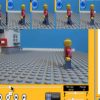CLAYMATION - WHAT IS IT?
Claymation or "clay stop motion animation" is essentially stop motion animation using clay. The word claymation is a joining of the words clay and animation, that is to say clay-animation to form claymation. Claymation software can be used to make these stop motion animation movies by combining lots of individual images of clay characters or clay forms.
Think of Gumby or Wallace and Gromit. Both arguably the best and most successful examples of clay animation.
It's worth noting that claymation is very popular for animation in education as it is a inexpensive way to introduce students to the art form.
Here we have given you some examples of claymation from some talented clay animators on youtube. We've also included the very first episode of Gumby S1 - E1 - Moon Trip. The third animation video is of Wallace and Gromit - with a nod to the Gumby moon landing.
Clay to be specific is better known as plasticine in the animation world. Plasticine is actually a brand of putty like modelling material made out of calcium salts, aliphatic acids and petroleum jelly. Its a trademark of Flair Leisure products PLC.
Is Coraline a Claymation?
No - Coraline is not a classic claymation movie in that it did not use hand made clay characters in general to create the puppets used in the movie. Instead Laika leveraged the new process of 3D printing to print some 6,333 printed faces. These allowed some 207,000 possible facial expressions. So the technique used was replacement animation. This is where your slot in a different face on the character to show a new expression or mouth movement. The characters or puppets where wire/armature framed but are better described as puppets or dolls rather than claymation characters. So it was stop motion just not "claymation" stop motion.


Is nightmare Before Christmas a Claymation?
No - The Tim Burton Nightmare before Christmas is not a claymation animation. The characters were not made of clay. It is better described as puppet stop motion.

WHAT IS THE BEST CLAY FOR CLAYMATION?
There are a number of plasticines or modelling clays available on the market. If you are new to claymation then make sure you choose the right type of clay. Some are water based others are oil based. You will want to avoid the water based ones. Read more on the subject of what the best clay for claymation is here. Alternatively we have given you a number of options on video here to the right from some trustworthy clay modellers and animators online via Youtube.
Plasticine clay appeared on the scene way back in 1897. It was created by a sculptor ( William Harbutt ) who needed a clay that was pliable and did not dry out. After some experimentation Harbutt combined calcium salts, petroleum jelly and aliphatic acids. It was trademarked in 1899 by Flari Leisa Products.
Why not try to make a simple claymation character from our tutorials here.
WHAT ARE SOME GOOD CLAYMATION IDEAS?
You are in luck when it comes to stop motion with clay. The sky is the limit. Because clay is some adaptable and malleable you can make anything your imagination will allow. Also you can make some very simple clay characters from clay that won't be a challenge to animate. Take for example Gumby or Pingu in Europe. Theses are very basic clay characters. Even more basic are Purple and Brown from Aardman. View examples of some of these characters here.
Claymation Idea 1 - Use simple characters
Taking this advice are some very talented amateur claymation animators on Youtube. One of the most popular is Robert Benfer. Take for example Kay World - Pancake mines. See how basic his clay figures are .. no eyes or mouth. He uses simple props to distinguish characters at times such as "yellow tie" guy. 6.4 Million views tells you something about how the sophistication of the animation is not the key to a good claymation. Simplicity and a good story line are the keys.
Claymation Idea 2 - Abstract Characters or Objects
Mamshmam is an exponent of this form of claymation. The clay figues are more like objects that morph in to different shapes frame by frame to engage the viewer. The story lines where they exist are very basic but the emphasis is on the sophistication of the movement. It gives you some good ideas on how to incorporate some interesting effects to your clay animations.
Claymation Idea 3 - Morphing shapes
Erica Wolfsen has created a very nice clay animation that is easy to replicate. The clay morphs in to a yellow donut at the end of the video. Why not try something like that yourself?
TOP 5 TIPS FOR BETTER CLAYMATION ANIMATIONS
Tip 1 - Use the right clay
Use the right type of plasticine / clay. Use the best oil based clay as mentioned above in this article. Fimo , Sculpey or Plastilina.
TIP 2 - SMOOTH SURFACES
Use a very smooth non porous surface on which to animate. Clay can tend to leave marks on porous or rough surfaces which will take from your viewers enjoyment of the animation. Marble, plastic or smooth polished wood surfaces are best.
Tip 3 - Manipulate alot
Manipulate your clay extensively to warm it and made is easy to mold to the shape you require. Note that a cold room will have an affect on your clay. If it is too cold then it may crack more easily. Try to keep the room temperature above 20 Degrees Centigrade / 68 Fahrenheit.
tip 4 - keep it clean
Clay has a habit of picking up tiny specs of dirt, fluff or hairs that might be lying around. Make sure you start off with a very clean surface. And constantly keep an eye out for anything dropping in to your set. It's too late often if dirt gets mixed in to your clay.
Tip 5 - Armature
If you are using armature make sure it is made correctly. It needs to be stiff enough to not loosen over time but not so stiff that it is hard to move. Using a good quality armature is key. Refer to the advice in this article for information on armature.
Classic examples of claymation
SOME GREAT EXAMPLES OF CLAYMATION ON THE NET
SIMPLE EXAMPLE OF A SHORT STORY
CLAYMATION DINOSAURS - GREAT SET AND SIMPLE!

MORE ADVISE ON THE BEST CLAY FOR CLAYMATION
We come across quite a few claymations online where animators use water based clay. You notice this by the cracks that appear in between frames. Its distracting for the viewer but also must be very frustrating for the animator. Below we give you advise on what clay to use and how to get the absolute best results from your efforts. Don't waste your time with the wrong clay. Check out the right one to use now.
WHEN DID CLAYMATION START?
Claymation animated films are a century old. In 1908 the Edison Manufacturing company created a film with live action and claymation. It was called The Sculptor’s Welsh Rarebit Dream. Three busts made of clay form while the hero lies asleep in a prison cell.
The term claymation was not introduced however in to wider use until Will Vinton trademarked the term in 1978. The morphing of the clay busts in the movie was most likely just called still frame capture animation.
Fun Facts about the first Claymation sequence
- Filmed in 1908
- An accidentally discovered film effect called "Trick Filming" by Georges Melies was used throughout the movie. ( Turning the camera off - allowing the subject to move out of frame - turning it back on again for a second - the off again while the subject moved back in frame and then on again - giving the impression of appearing out of thin air )
So you could say that Edwin Porter ( the director and pioneer of trick filming ) and Thomas Edison invented claymation as we know it today.
Many other examples of the use of claymation followed and kept audiences in wonder of the magic of cinema for years to come. However there was something of a hiatus between the 20's and the 1950's when Gumby once again popularized claymation.

